By Leen Randell
Updated: Jul 08, 2024
10 Best Herbal Decoctions For Fatigue
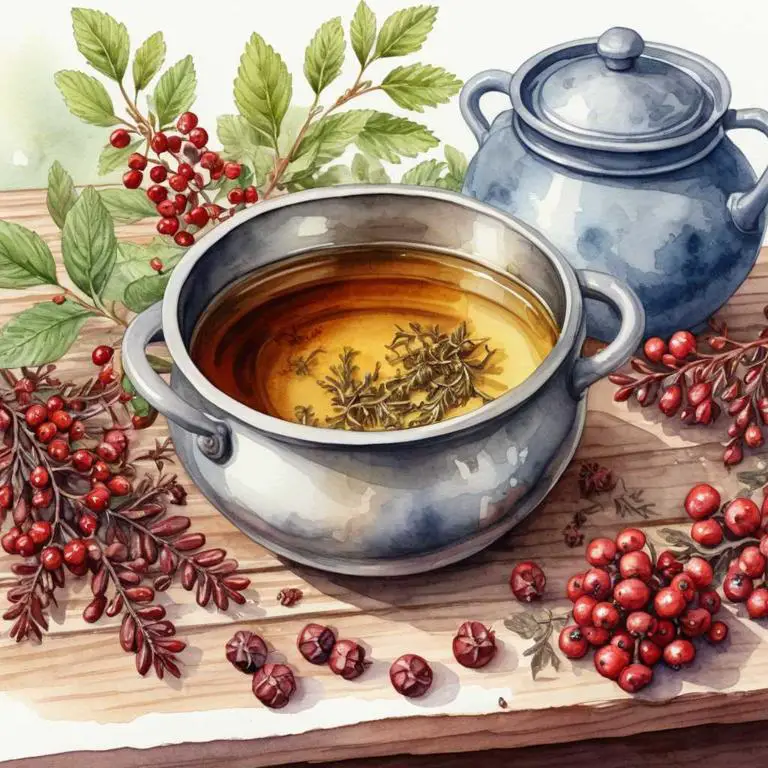
Herbal decoctions for fatigue are a natural remedy made by steeping herbs in hot water to create a soothing drink.
These decoctions can help alleviate fatigue by addressing underlying physical and emotional imbalances, such as stress, insomnia, and poor digestion. Examples of herbal decoctions that can help with fatigue include ginger, ashwagandha, and ginseng, which have been shown to increase energy levels and improve mental clarity.
By incorporating these decoctions into daily routines, individuals can experience improved mood, increased productivity, and enhanced overall well-being.
The following article describes in detail the most important decoctions for fatigue, including medicinal properties, parts of herbs to use, and recipes for preparations.
- 1. Panax ginseng
- 2. Withania somnifera
- 3. Hypericum perforatum
- 4. Ginkgo biloba
- 5. Echinacea angustifolia
- 6. Glycyrrhiza glabra
- 7. Mentha x piperita
- 8. Valeriana officinalis
- 9. Melissa officinalis
- 10. Eleutherococcus senticosus
- What is the best combination of herbal decoctions to use for fatigue?
- What ailments similar to fatigue are treated with herbal decoctions?
1. Panax ginseng
Ginseng decoctions helps with fatigue because it stimulates blood circulation, increasing oxygenation to cells and tissues.
This enhances mental clarity and reduces physical exhaustion. Additionally, ginseng's adaptogenic properties help regulate stress hormones, allowing the body to better cope with daily demands. As a result, herbal ginseng decoctions can improve overall energy levels, reducing feelings of lethargy and increasing vitality.
By promoting a sense of balance and harmony within the body, it helps individuals regain their natural energy and zest for life.
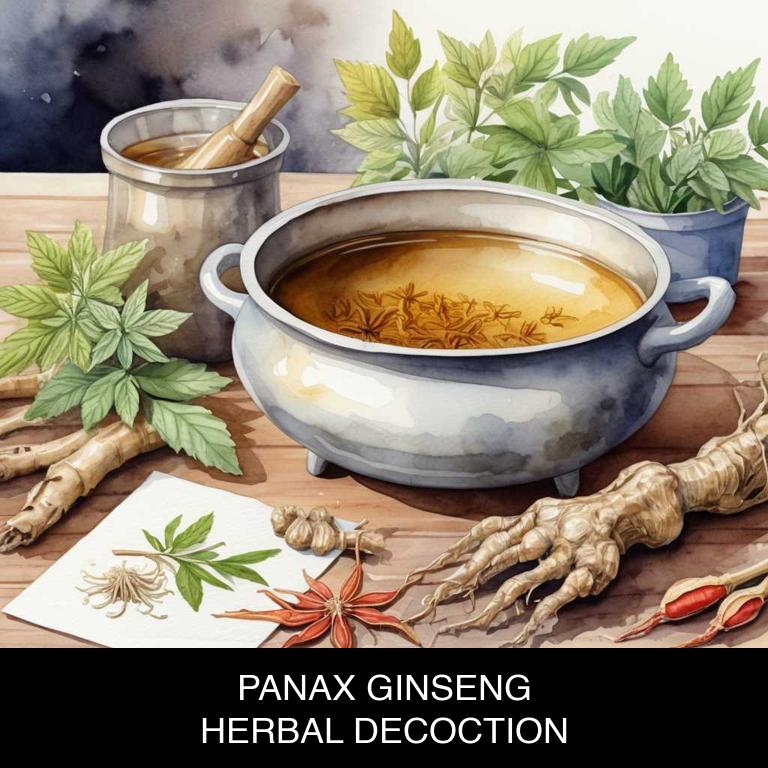
Medicinal Constituents
The list below shows the primary medicinal constituents in Panax ginseng decoctions that help with fatigue.
- Ginsenosides: These triterpenoid saponins help reduce fatigue by modulating the body's energy metabolism, improving mitochondrial function, and enhancing the body's ability to adapt to stress.
- Glycosides: Specifically, the glycoside compound ginsenoside Rg1, helps to reduce fatigue by promoting the production of ATP (adenosine triphosphate), the primary energy currency of the body, and enhancing the function of the mitochondria.
- Ergosterol peroxide: This triterpenoid compound helps to reduce fatigue by inhibiting the production of pro-inflammatory cytokines, which can contribute to fatigue, and promoting the production of anti-inflammatory cytokines that support overall health and well-being.
Parts Used
The list below shows the primary parts of ginseng used to make decoctions for fatigue.
- Roots: The primary part of Panax ginseng used for decoctions is its roots, as they contain the highest concentration of ginsenosides, which are believed to be responsible for the plant's medicinal properties.
- Stems: The stems of Panax ginseng are also used, as they have a higher concentration of ginsenosides than the leaves, making them a viable alternative for decoctions.
- Leaves: The leaves are occasionally used, although they contain lower concentrations of ginsenosides than the roots and stems, they can still be effective in reducing fatigue due to their adaptogenic properties.
Quick Recipe
The following recipe gives a procedure to make a basic ginseng for fatigue.
- Weigh 3 to 4 grams of dried panax ginseng root to prepare the decoction.
- Combine the weighed root with 4 cups of water in a saucepan and heat.
- Bring the mixture to a boil then reduce the heat to a simmer for 30 minutes.
- Strain the decoction through a cheesecloth into a separate container to remove the solids.
- Allow the decoction to cool to room temperature before consuming it.
2. Withania somnifera
Ashwagandha decoctions helps with fatigue because they contain adaptogenic properties that help the body respond to stress, promoting balance and reducing exhaustion.
By increasing antioxidant levels and improving sleep quality, ashwagandha helps reduce inflammation and oxidative stress caused by prolonged fatigue.
Additionally, its ability to regulate cortisol levels and stimulate energy production in cells helps alleviate feelings of tiredness and sluggishness, allowing for a more sustained and revitalized sense of well-being.
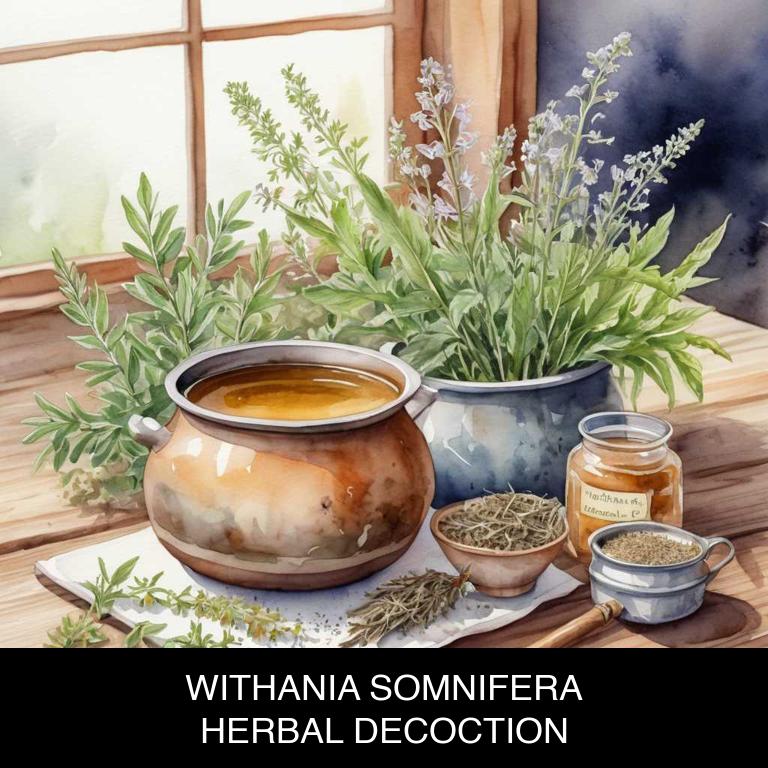
Medicinal Constituents
The list below shows the primary medicinal constituents in Withania somnifera decoctions that help with fatigue.
- Withanolides: These steroidal lactones have anti-inflammatory and antioxidant properties, which help reduce oxidative stress and promote energy production in cells, ultimately alleviating fatigue.
- Alkaloids: These compounds have been shown to improve mitochondrial function and increase ATP production, thereby enhancing energy levels and reducing fatigue.
- Saponins: These triterpenoid saponins exhibit adaptogenic properties, helping the body adapt to stress and promoting a balance in physiological functions, which can lead to improved endurance and reduced fatigue.
Parts Used
The list below shows the primary parts of ashwagandha used to make decoctions for fatigue.
- Roots: The roots of Withania somnifera are the most commonly used part for making decoctions due to their high concentration of bioactive compounds like withanolides and alkaloids, which are responsible for their medicinal properties.
- Leaves: The leaves of Withania somnifera are also used to make decoctions, as they contain withanolides and other bioactive compounds that can help alleviate fatigue and promote relaxation.
- Fruits: The fruits of Withania somnifera are used to make decoctions, as they are rich in withanolides and other bioactive compounds that can help reduce fatigue and promote overall well-being.
Quick Recipe
The following recipe gives a procedure to make a basic ashwagandha for fatigue.
- Measure out 3-6 grams of dried withania somnifera root for a standard decoction.
- Combine the measured withania somnifera root with 1 liter of water in a saucepan.
- Boil the mixture over high heat for 5-10 minutes to activate the herbal compounds.
- Reduce the heat to a simmer and continue cooking for an additional 10-20 minutes.
- Strain the decoction through a cheesecloth or fine-mesh sieve into a clean container.
3. Hypericum perforatum
St John's Wort decoctions helps with fatigue because of its adaptogenic properties, which allow it to boost the body's energy levels by interacting with neurotransmitters and hormones.
The herb contains hyperforin, a compound that increases the production of ATP, the body's primary source of energy. Additionally, St John's Wort's antiviral and antibacterial properties help combat underlying infections or inflammation that may be contributing to fatigue.
By addressing these root causes, St John's Wort decoctions can help restore vitality and alleviate feelings of exhaustion.
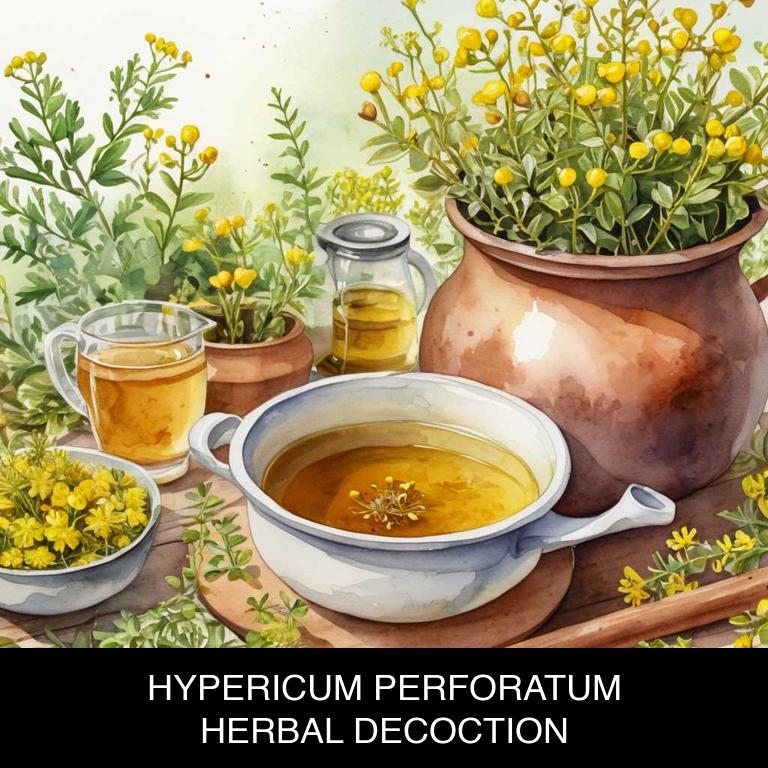
Medicinal Constituents
The list below shows the primary medicinal constituents in Hypericum perforatum decoctions that help with fatigue.
- Hyperforin: This terpene helps with fatigue by increasing the levels of neurotransmitters such as serotonin and dopamine in the brain, which play a crucial role in regulating mood and energy levels.
- Hypericin: This naphthodianthrone acts as an antioxidant and can help reduce oxidative stress and inflammation in the body, which can contribute to fatigue and exhaustion.
- Quercetin: This flavonoid has anti-inflammatory properties and can help improve the body's energy production by increasing the activity of enzymes involved in the production of ATP (adenosine triphosphate), the primary energy currency of the cell.
Parts Used
The list below shows the primary parts of st john's wort used to make decoctions for fatigue.
- Leaves: Leaves are a common choice due to their high concentration of flavonoids and other bioactive compounds that help alleviate fatigue.
- Flowers: Flowers are often used for their antioxidant and anti-inflammatory properties, which can help reduce stress and fatigue.
- Roots: Roots are a popular choice for their rich content of hypericin and hyperforin, which have been shown to improve mood and reduce fatigue.
Quick Recipe
The following recipe gives a procedure to make a basic st john's wort for fatigue.
- Harvest 30 grams of fresh st john's wort flowers and leaves when in full bloom for best potency.
- Dry the harvested plant material in a warm place for 7-10 days to remove moisture completely.
- Weigh out 2-3 grams of dried st john's wort per 250 milliliters of water for a standard decoction.
- Combine the weighed dried plant material with water in a saucepan and bring to a boil over medium heat.
- Reduce heat to low and simmer for 10-15 minutes to extract active compounds from the plant material.
4. Ginkgo biloba
Maidenhair tree decoctions helps with fatigue because they contain a unique combination of adaptogenic compounds that work to regulate the body's energy levels.
The decoction's active ingredients, such as flavonoids and terpenes, help to calm the nervous system, reducing feelings of exhaustion and increasing mental clarity. Additionally, the decoction's antioxidants work to neutralize free radicals, which can contribute to fatigue by damaging cells and tissues.
By promoting a sense of balance and rejuvenation, maidenhair tree decoctions provide natural relief from fatigue and promote overall well-being.
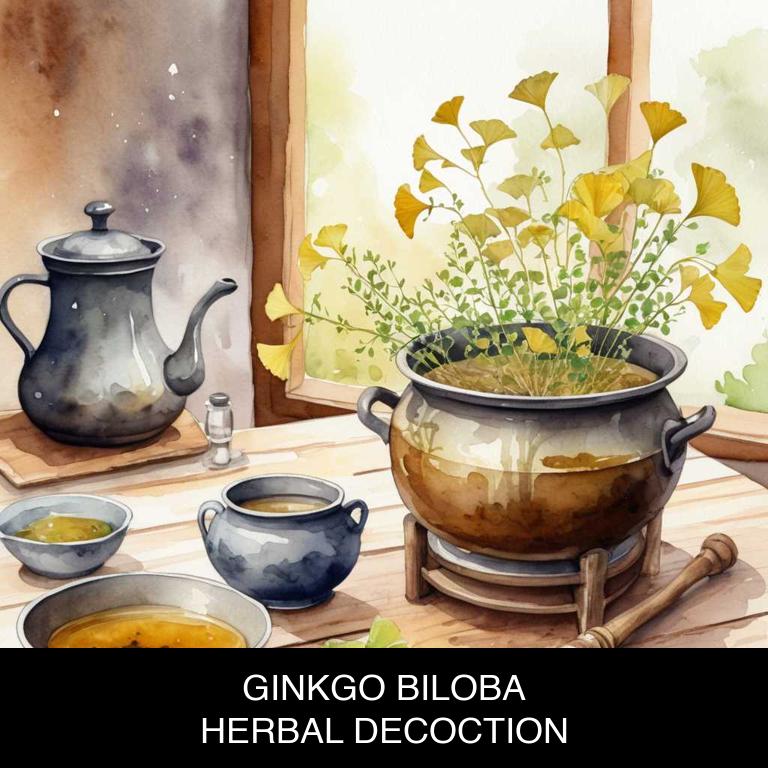
Medicinal Constituents
The list below shows the primary medicinal constituents in Ginkgo biloba decoctions that help with fatigue.
- Flavonoids: These compounds help reduce oxidative stress and inflammation, which can contribute to fatigue by improving blood flow and enhancing energy metabolism.
- Terpene lactones: These terpene lactones have anti-inflammatory and antioxidant properties, which can help alleviate fatigue by reducing inflammation and oxidative stress in the body.
- Bilobalide: This triterpene has antioxidant and anti-inflammatory properties, which can help reduce fatigue by protecting cells from oxidative damage and promoting healthy blood flow to the brain and other organs.
Parts Used
The list below shows the primary parts of maidenhair tree used to make decoctions for fatigue.
- Leaves: The leaves are used to make decoctions for fatigue due to their rich content of flavonoids and terpenoids, which are believed to improve blood flow and reduce oxidative stress.
- Seeds: The seeds are used to make decoctions for fatigue as they contain ginkgolic acid, which is thought to have anti-inflammatory and antioxidant properties that help alleviate fatigue.
- Barks: The barks are used to make decoctions for fatigue due to their content of flavonoids and terpenoids, which are believed to have a similar effect on blood flow and oxidative stress as the leaves.
Quick Recipe
The following recipe gives a procedure to make a basic maidenhair tree for fatigue.
- Harvest ginkgo biloba leaves from mature trees in late summer or early fall when the leaves turn yellow.
- Dry the harvested leaves in a low-temperature oven at 150 degrees fahrenheit for 2 hours.
- Grind 2-3 grams of dried ginkgo biloba leaves into a fine powder using a mortar and pestle.
- Combine the powder with 1 liter of boiling water in a saucepan and steep for 15 minutes.
- Strain the decoction through a cheesecloth or fine-mesh sieve into a clean container and discard the solids.
5. Echinacea angustifolia
Kansas coneflower decoctions helps with fatigue because it contains powerful antioxidants and anti-inflammatory compounds that can help reduce oxidative stress and alleviate muscle weakness.
The decoction's bioactive constituents, such as triterpenoids and phenolic acids, can also enhance energy production in cells by increasing ATP synthesis.
Additionally, the herbal remedy may help regulate cortisol levels, which can become imbalanced due to prolonged fatigue, leading to improved overall energy levels and reduced feelings of exhaustion.
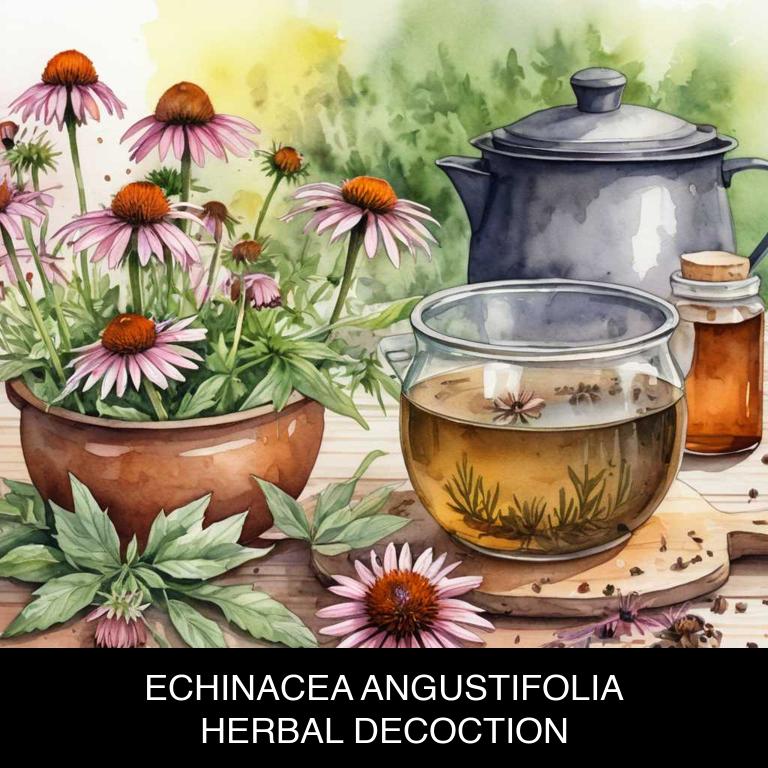
Medicinal Constituents
The list below shows the primary medicinal constituents in Echinacea angustifolia decoctions that help with fatigue.
- Iridoid glycosides: These compounds have been shown to exhibit antioxidant and anti-inflammatory properties, which can help alleviate fatigue by protecting cells from oxidative damage and reducing inflammation that may contribute to fatigue.
- Alkylamides: Alkylamides in Echinacea angustifolia have been found to have immunomodulatory effects, which can help regulate the immune system and reduce fatigue by stimulating the production of cytokines that help fight off infections and reduce inflammation.
- Caffeic acid: Caffeic acid, a phenolic compound present in Echinacea angustifolia, has been demonstrated to possess antioxidant and anti-inflammatory properties, which can help alleviate fatigue by protecting cells from oxidative damage and reducing inflammation that may contribute to fatigue.
Parts Used
The list below shows the primary parts of kansas coneflower used to make decoctions for fatigue.
- Roots: Roots are the primary part used due to their high concentration of compounds like echinacoside and alkylamides, which are believed to help alleviate fatigue.
- Leaves: Leaves are another commonly used part, as they contain similar compounds to the roots, contributing to their fatigue-reducing properties.
- Stems: Stems are sometimes used, although to a lesser extent, as they contain a smaller amount of bioactive compounds compared to roots and leaves.
Quick Recipe
The following recipe gives a procedure to make a basic kansas coneflower for fatigue.
- Harvest echinacea angustifolia roots in late summer or early fall when plants are in bloom.
- Clean and dry the roots immediately to preserve their medicinal properties for future use.
- Chop the dried roots into small pieces to increase their surface area for infusion.
- Combine 1 part of the chopped roots with 2 parts of boiling water in a saucepan.
- Simmer the mixture for 10-15 minutes and strain it through a cheesecloth to obtain the decoction.
6. Glycyrrhiza glabra
Licorice decoctions helps with fatigue because they contain compounds that stimulate the adrenal glands, which play a crucial role in regulating energy levels.
The glycyrrhizin present in licorice root has been shown to increase cortisol production, helping to combat feelings of exhaustion and burnout. Additionally, licorice's adaptogenic properties allow it to harmonize with the body's natural rhythms, promoting a sense of balance and vitality.
As a result, herbal licorice decoctions can be a valuable ally in managing fatigue and promoting overall well-being.

Medicinal Constituents
The list below shows the primary medicinal constituents in Glycyrrhiza glabra decoctions that help with fatigue.
- Glycyrrhizin: Glycyrrhizin helps with fatigue by inhibiting the activity of 11-beta-hydroxysteroid dehydrogenase, an enzyme that converts cortisol into its inactive form. By blocking this conversion, glycyrrhizin helps maintain cortisol levels, which can aid in reducing fatigue.
- Saponins: Saponins help with fatigue by stimulating the adrenal glands to produce more cortisol, a hormone that plays a crucial role in managing stress and fatigue.
- Flavonoids: Flavonoids help with fatigue by exhibiting antioxidant and anti-inflammatory properties, which can help alleviate oxidative stress and inflammation that contribute to fatigue.
Parts Used
The list below shows the primary parts of licorice used to make decoctions for fatigue.
- Roots: Rich in glycyrrhizin, a compound that helps to reduce inflammation and alleviate fatigue.
- Barks: Containing various bioactive compounds that may help to reduce oxidative stress and fatigue.
- Leaves: Containing antioxidants and other compounds that may help to boost energy levels and reduce fatigue.
Quick Recipe
The following recipe gives a procedure to make a basic licorice for fatigue.
- Harvest 10-15 grams of dried glycyrrhiza glabra roots from a reputable source to use in the decoction.
- Grind the roots into a fine powder using a mortar and pestle to increase their surface area.
- Combine 1 teaspoon of the ground roots with 250 milliliters of water in a saucepan to create the decoction.
- Boil the mixture over medium heat for 5-7 minutes to release the active compounds from the roots.
- Strain the decoction through a cheesecloth or a fine-mesh sieve into a cup to remove the solids.
7. Mentha x piperita
Peppermint decoctions helps with fatigue because it stimulates the mind and body, promoting a sense of alertness and refreshing energy.
The menthol in peppermint oil has natural analgesic properties that help reduce mental fogginess and increase oxygen flow to the brain, banishing feelings of tiredness and sluggishness.
Additionally, peppermint's calming effects on the digestive system can alleviate bloating and discomfort associated with fatigue, leaving you feeling revitalized and ready to tackle the day.
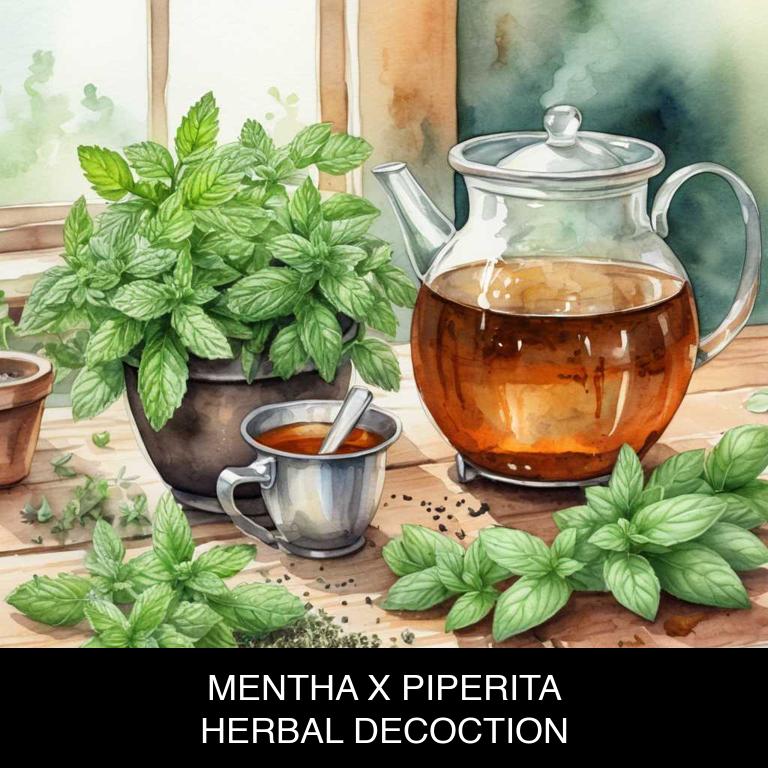
Medicinal Constituents
The list below shows the primary medicinal constituents in Mentha x piperita decoctions that help with fatigue.
- Rosmarinic acid: A phenolic compound that helps reduce oxidative stress and inflammation, which can contribute to fatigue by promoting a sense of well-being and relaxation.
- Menthone: A monoterpene that has been shown to have a stimulating effect on the nervous system, helping to increase alertness and reduce fatigue by promoting a sense of energy and vitality.
- Menthyl acetate: A monoterpenoid ester that has a mild stimulant effect, helping to increase circulation and reduce fatigue by promoting a sense of refreshment and rejuvenation.
Parts Used
The list below shows the primary parts of peppermint used to make decoctions for fatigue.
- Leaves: Leaves are widely used due to their high concentration of menthol and menthone, which have a refreshing and invigorating effect.
- Stems: Stems contain menthol and other volatile oils that help to reduce fatigue and improve mental clarity.
- (optional) roots: Roots also contain menthol and other compounds that have a stimulating effect, but they are less commonly used than leaves and stems due to their lower concentration of essential oils.
Quick Recipe
The following recipe gives a procedure to make a basic peppermint for fatigue.
- Gather 2 ounces of fresh menthax piperita leaves or 1 ounce dried leaves and clean them thoroughly.
- Crush 1 tablespoon of the gathered menthax piperita leaves to release their essential oils and flavors.
- Combine the crushed menthax piperita leaves with 16 ounces of boiling water in a heat-resistant container.
- Steep the mixture for 10 to 15 minutes to allow the flavors and oils to infuse fully.
- Strain the mixture and discard the solids to obtain a fresh herbal decoction.
8. Valeriana officinalis
Valerian decoctions helps with fatigue because it acts as a natural stimulant to the body, promoting relaxation and reducing stress levels.
The valerenic acids present in the herb help to increase the production of serotonin, a neurotransmitter that regulates mood and energy. This can lead to an improvement in overall sleep quality and a reduction in daytime fatigue.
Additionally, valerian's sedative properties can also help to calm the nervous system, allowing individuals to recharge and feel more energized throughout the day.
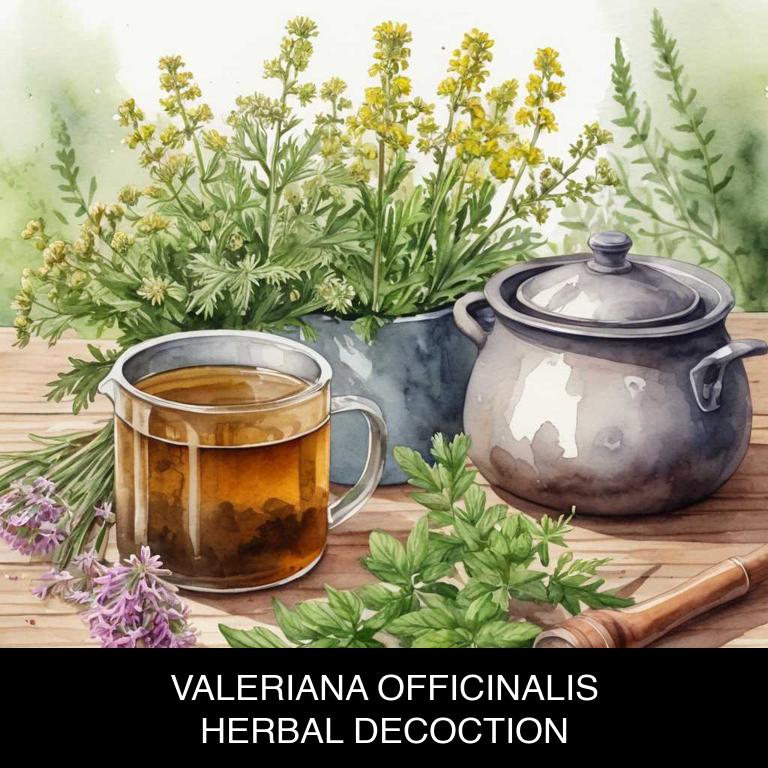
Medicinal Constituents
The list below shows the primary medicinal constituents in Valeriana officinalis decoctions that help with fatigue.
- Valerenic acid: This sesquiterpene acts as a GABA receptor agonist, promoting relaxation and reducing fatigue by modulating the body's sleep-wake cycle and alleviating stress.
- Isovaleric acid: A short-chain fatty acid, isovaleric acid has been shown to have sedative and anxiolytic properties, helping to alleviate fatigue by promoting a sense of calmness and reducing anxiety.
- Valeranone: A terpenoid compound, valeranone has been found to have a sedative effect, helping to reduce fatigue by promoting relaxation and improving sleep quality.
Parts Used
The list below shows the primary parts of valerian used to make decoctions for fatigue.
- Roots: They contain the highest concentration of valerenic acid, a key component responsible for the plant's sedative and relaxing properties.
- Barks: The bark contains bioactive compounds that contribute to the plant's calming and sleep-promoting effects, making it a popular choice for fatigue relief.
- Leaves: The leaves are rich in valerenic acid and other compounds that help reduce stress and anxiety, promoting relaxation and reducing fatigue.
Quick Recipe
The following recipe gives a procedure to make a basic valerian for fatigue.
- Harvest 1-2 ounces of fresh or dried roots of valeriana officinalis from a trusted source in late summer.
- Clean the roots thoroughly with filtered water to remove any dirt or debris from the harvesting process.
- Combine the cleaned roots with 2 cups of boiling water in a non-reactive saucepan to create the decoction.
- Steep the roots in the boiling water for 5-7 minutes to allow the active compounds to infuse into the liquid.
- Strain the decoction through a cheesecloth or fine-mesh sieve into a clean container to remove the solids.
9. Melissa officinalis
Lemon balm decoctions helps with fatigue because it possesses a unique combination of bioactive compounds, including rosmarinic acid, citral, and limonene, which work synergistically to alleviate physical and mental exhaustion.
The soothing and calming properties of lemon balm help to reduce stress and anxiety, allowing the body to conserve energy.
Additionally, its adaptogenic effects help to boost vitality and improve overall endurance, making it an effective natural remedy for combating fatigue and promoting a sense of revitalization and well-being.
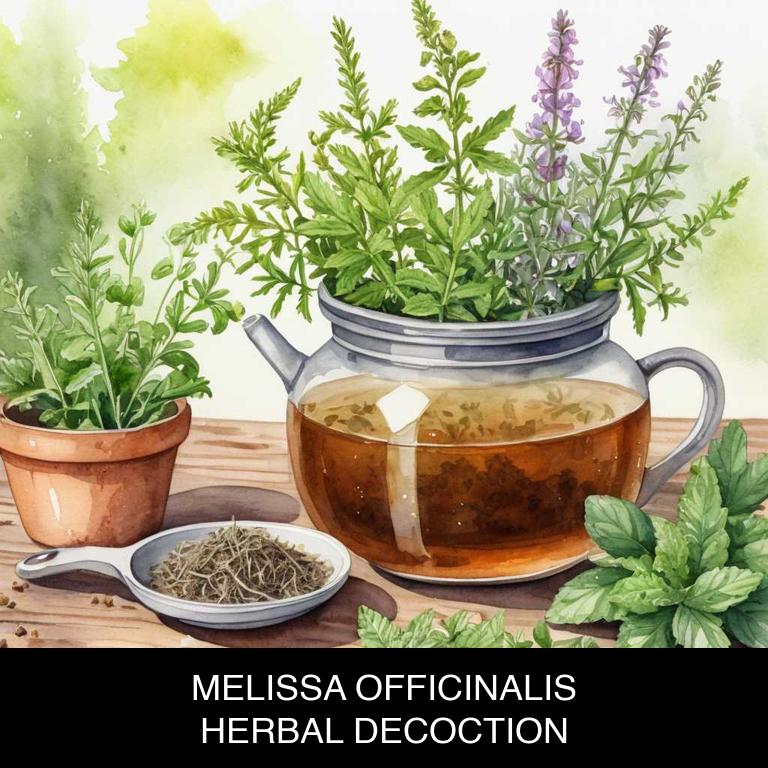
Medicinal Constituents
The list below shows the primary medicinal constituents in Melissa officinalis decoctions that help with fatigue.
- Rosmarinic acid: A polyphenolic compound that helps alleviate fatigue by reducing inflammation and oxidative stress, thus promoting relaxation and reducing mental exhaustion.
- Luteolin: A flavonoid with antioxidant properties that helps mitigate fatigue by protecting cells from damage caused by free radicals and enhancing the body's energy production.
- Geraniol: A terpene with sedative and relaxing properties that helps alleviate fatigue by promoting better sleep quality, reducing anxiety, and calming the nervous system.
Parts Used
The list below shows the primary parts of lemon balm used to make decoctions for fatigue.
- Leaves: Rich in antioxidants and essential oils, which help to reduce fatigue and promote relaxation.
- Flowers: Contain melissic acid and other compounds that can help to alleviate anxiety and stress associated with fatigue.
- Roots: May contain bioactive compounds that help to regulate the body's energy levels and reduce fatigue.
Quick Recipe
The following recipe gives a procedure to make a basic lemon balm for fatigue.
- Harvest melissa officinalis leaves and flowers in the morning after the dew has evaporated to ensure freshness.
- Chop 20-30 grams of melissa officinalis leaves and flowers into small pieces to increase surface area.
- Combine chopped melissa officinalis with 1 liter of boiling water in a large glass container to create decoction.
- Steep the mixture for 5-10 minutes to allow the active compounds to infuse into the water.
- Strain the decoction through a cheesecloth or fine-mesh sieve into a separate container to remove solids.
10. Eleutherococcus senticosus
Siberian ginseng decoctions helps with fatigue because it is rich in bioactive compounds that stimulate the body's natural energy production.
The decoction has been shown to increase ATP levels, enhance oxygen delivery to cells, and boost antioxidant defenses, all of which contribute to improved physical endurance. Additionally, Siberian ginseng has been found to promote relaxation and reduce stress levels, further alleviating feelings of fatigue.
By revitalizing the body's energy reserves, Siberian ginseng decoctions can help individuals overcome exhaustion and regain their vitality.
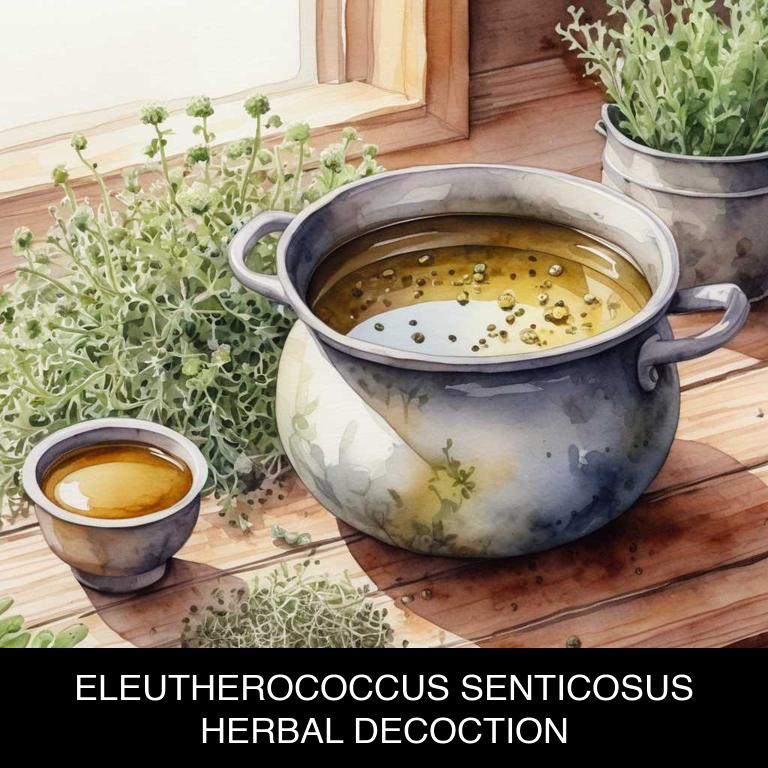
Medicinal Constituents
The list below shows the primary medicinal constituents in Eleutherococcus senticosus decoctions that help with fatigue.
- Eleutherosides: These compounds help alleviate fatigue by enhancing cellular energy production, improving mitochondrial function, and stimulating the production of ATP (adenosine triphosphate), the primary energy currency of cells.
- Phenolic acids: These antioxidants neutralize free radicals, reduce oxidative stress, and enhance the body's energy metabolism, thus contributing to fatigue relief.
- Acetylshikonin: This compound stimulates the production of ATP, improves muscle endurance, and enhances exercise performance by promoting the expression of genes involved in energy metabolism.
Parts Used
The list below shows the primary parts of siberian ginseng used to make decoctions for fatigue.
- Roots: The roots are rich in bioactive compounds and are often used for their adaptogenic and fatigue-reducing properties.
- Stems: The stems of Eleutherococcus senticosus are used due to their high content of eleutherosides, which are believed to help alleviate fatigue and improve overall well-being.
- Barks: The barks are used to create decoctions that can help increase endurance and reduce fatigue, likely due to their high concentration of eleutherosides and other bioactive compounds.
Quick Recipe
The following recipe gives a procedure to make a basic siberian ginseng for fatigue.
- Harvest 10-20 grams of eleutherococcus senticosus roots in late summer or early fall when they are mature and dry.
- Clean and dry the harvested roots thoroughly to remove any dirt or debris from storage.
- Chop the dried roots into smaller pieces to increase their surface area for infusion.
- Combine the chopped roots with 500ml of boiling water in a heat-resistant container to create a decoction.
- Simmer the decoction for 10-15 minutes to allow the active compounds to infuse into the water.
What is the best combination of herbal decoctions to use for fatigue?
The best combination of herbal decoctions that help with fatigue is a blend of Ginseng, Ashwagandha, and Licorice root.
Ginseng stimulates the body's energy and vitality, while Ashwagandha reduces stress and anxiety, promoting a sense of calm and balance. Licorice root, with its anti-inflammatory properties, helps to soothe the digestive system and boost the body's natural energy reserves. This synergistic combination can help alleviate fatigue, increase mental clarity, and promote overall well-being.
Regular consumption may lead to improved physical and mental resilience.
What ailments similar to fatigue are treated with herbal decoctions?
Ailments similar to fatigue/decoctions.html">fatigue/decoctions.html">fatigue that are treated with herbal decoctions are stress, anxiety, insomnia, and depression.
Herbs like Ashwagandha, St. John's Wort, and Valerian root are commonly used to calm the nervous system and promote relaxation.
Decoctions of Ginkgo biloba and Bacopa monnieri have been shown to improve mental clarity and memory, while those containing Rhodiola rosea can increase energy levels and reduce fatigue.